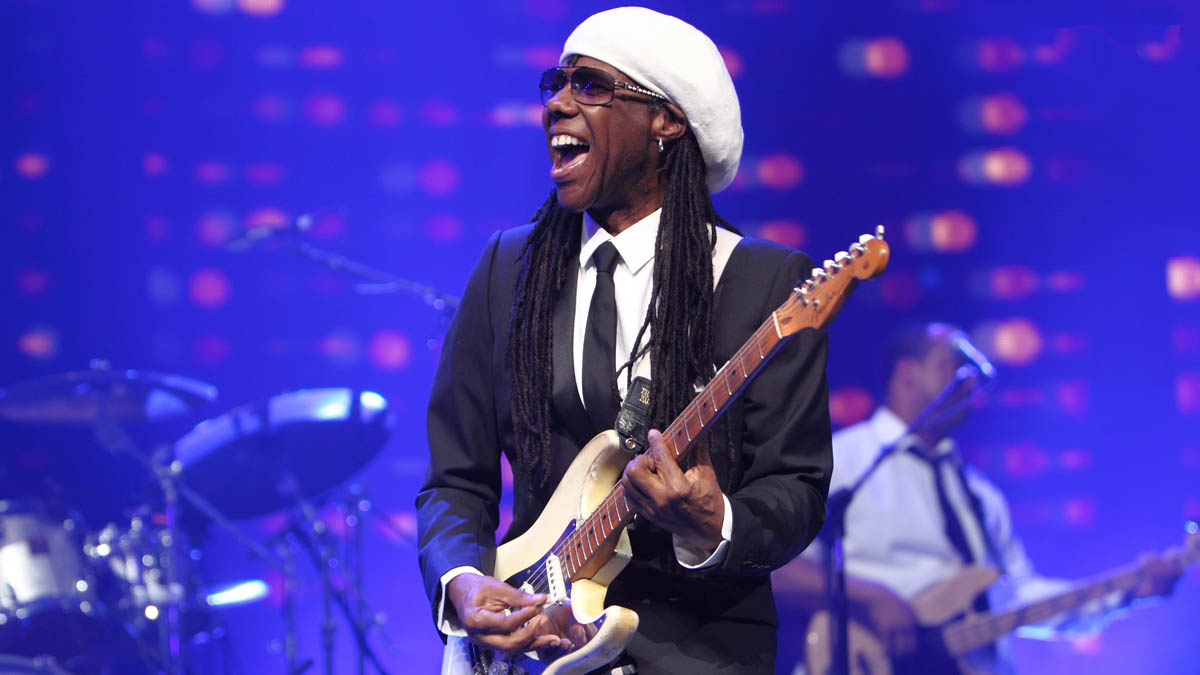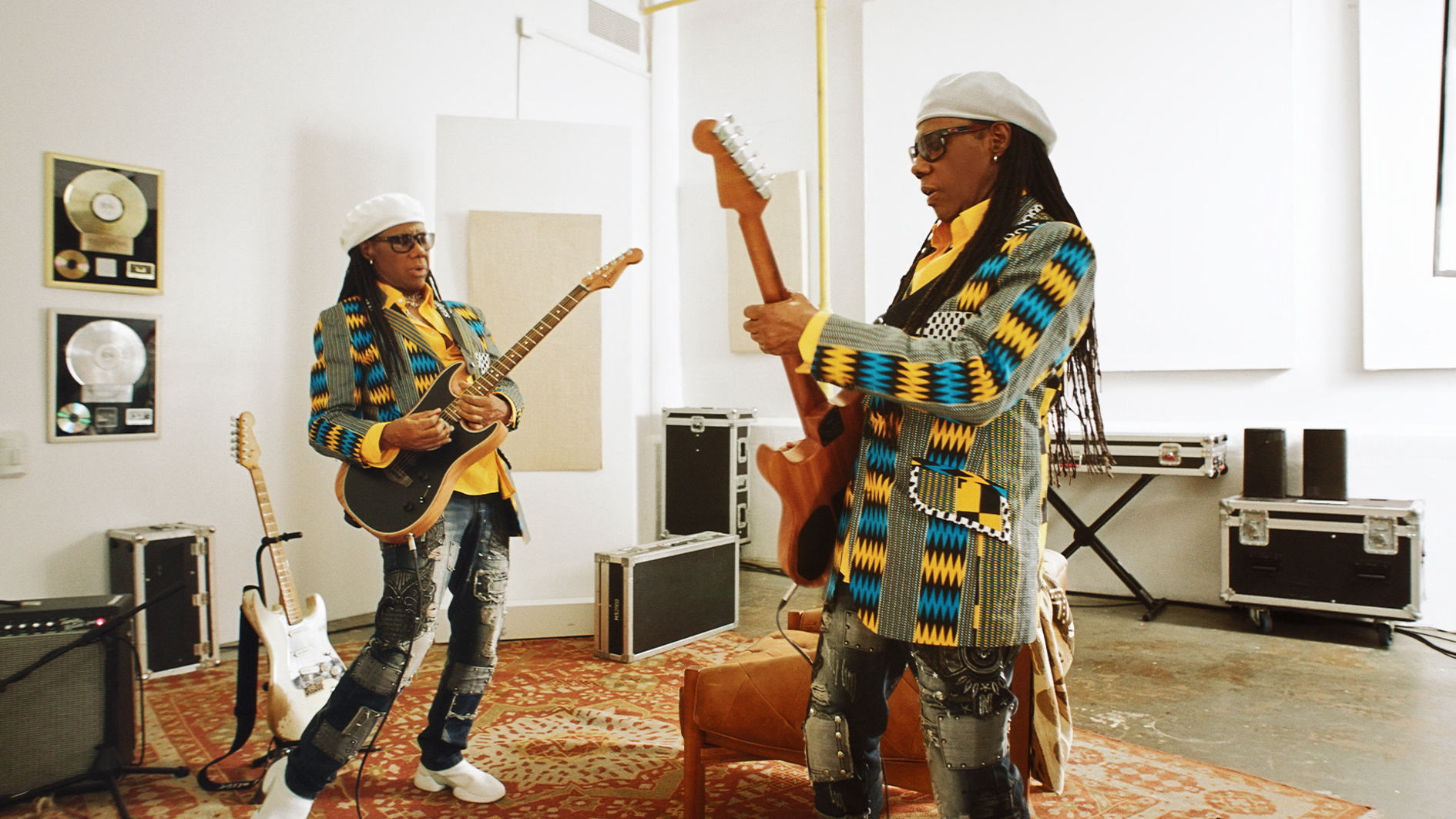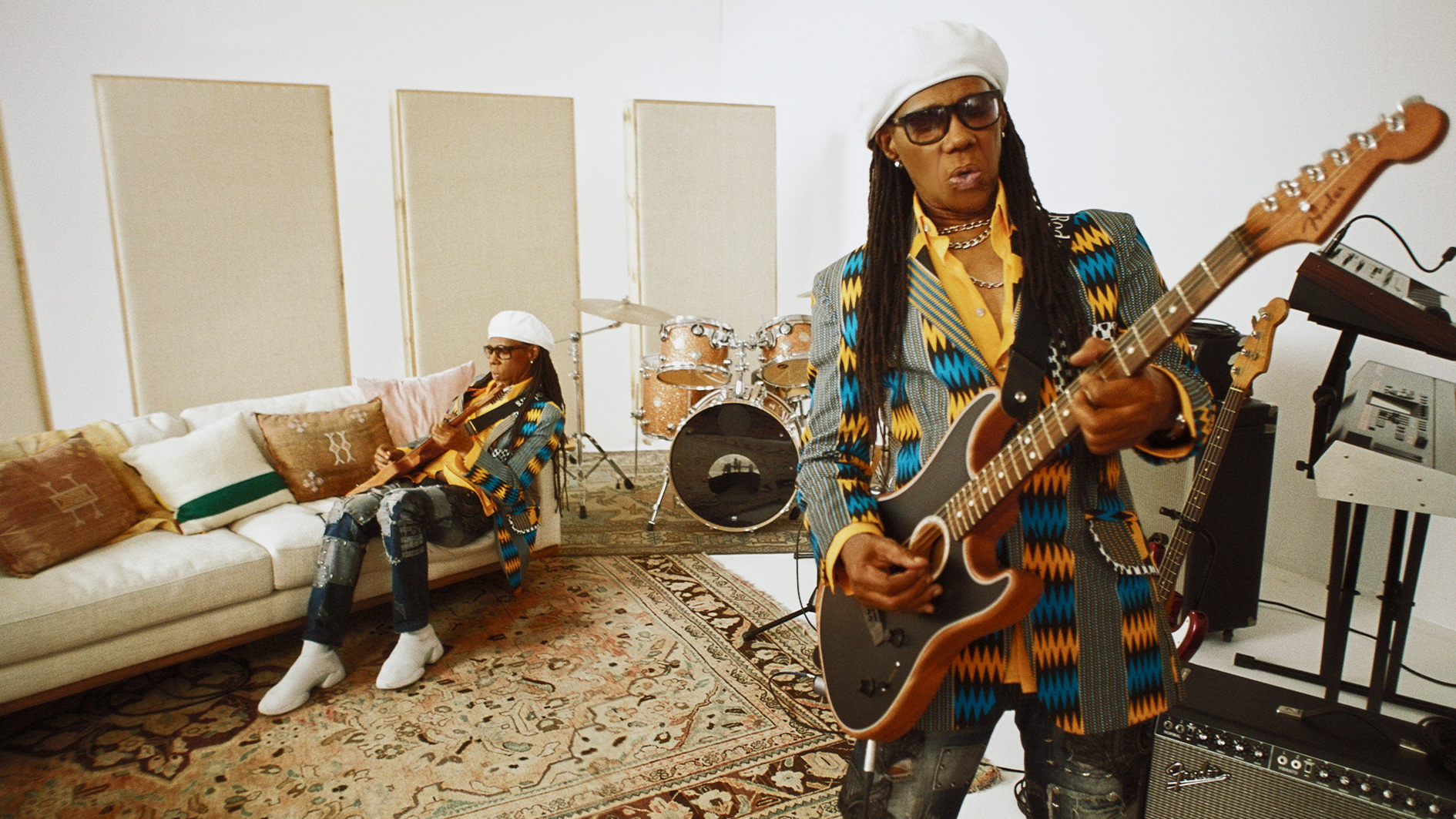Nile Rodgers: “To me, the less information I throw at you at once, the funkier something sounds“
The Hitmaker himself talks about his love of jazz, the possibilities of the Acoustasonic and the importance of the notes he doesn't play

To call Nile Rodgers’ guitar-playing career a success is a gross understatement. More than $2 billion worth of music has been recorded with his ‘Hitmaker’ Strat, a guitar that cost him just $149 and which, at the time, he wasn’t even sure he should buy. He’s not regretting that purchase anymore, to say the least.
We caught up with the Hitmaker himself while he was in town testing out the new Acoustasonic version of Fender’s ever-adaptable Strat at Abbey Road.
Here, he opens up about the secrets behind his hyper-effective rhythm playing, his enduring love of jazz guitar and why being upstaged back in the 70s led to him picking up a Strat for the first time.
You recently filmed a video for Fender in which you’re playing the new Acoustasonic Stratocaster. It’s quite a departure from the ‘Hitmaker’ Strat you’re known for using. What attracted you to it?
“They gave it to me over at Abbey Road and I was just putting the guitar through its paces. And the next thing you know I wound up doing session after session after session – just over and over and over again, trying to figure out what the guitar did. And as I did it I wound up having so much fun playing it that I just didn’t stop playing it – it was a weird thing. It sort of grew on me almost right away… I really love jazz guitars, I just can’t help it.
“When I’m sitting at home and I practise, I’m playing a D’Aquisto or a D’Angelico or an L-5, and typically I have the L-5 in my bedroom, because it’s just right there and the other ones have to go to my locker. But by having this guitar and starting to play jazz on it, I was like, ‘Oh wow, it’s doing what I like jazz guitars to do.’
“I can hear it in the room, but when I amplify it, it’s got the same kind of vibe – I can manipulate it and I can do what I can do with an L-5. And, just think, I haven’t had to put flat-wound strings on it: I’m still using the acoustic strings that came on the guitar. I haven’t changed them since I got it.
Get The Pick Newsletter
All the latest guitar news, interviews, lessons, reviews, deals and more, direct to your inbox!
“Some people laugh, but old-school guitarists keep their strings on their guitars for a really long time. It’s just a thing. I don’t know if it’s an R&B thing or a blues thing or a black thing or whatever, but it’s just something that we do.
“My guitar techs know that I’m gonna have an attitude if I say, ‘Did you change my strings last night?’ and they say ‘Err, yeah, man, we changed them before the last show….’ It’s just a thing, man, and I can’t explain it, but I like old guitar strings.”
Which jazz guitarists influenced your own style the most?
“I started out really, really loving Wes Montgomery and then for a bit I started to go into the Django Reinhardt school – I really got into the Gypsy jazz thing. But then practical life tends to take over and I realised that my life was going to be, for a certain amount of time, playing other people’s music.
“That was going to be my job: I was not going to play my own music, I was going to play other people’s music. I needed to have a guitar that satisfied composers and producers and artists, so I started playing different styles of hollowbody guitar. Eventually, I worked my way to a 335 and then that just didn’t quite feel right to me, and so I went back to the other big box guitars.”

Why did you make the switch to becoming a Strat player?
“We were opening for The Jackson 5 on the first leg of their first world tour in 1973 and we were substituting for a really great R&B band called the O’Jays. Whenever they had a headlining gig, they didn’t want to open for the Jacksons, so they would turn it over to my band.
“We were a group called New York City. We had a hit record called I’m Doin’ Fine Now – we toured on that record for about two or three years. One day we were doing a gig that we were headlining and we had an opening act; it was a young kid.
“We didn’t want to have a stage changeover because we weren’t that big, so we would just let the opening act use our gear. And so this young kid plugged into my amp, and at that time I was playing through an Acoustic [brand] amp with the horn in it, because we all wanted to look like Sly And The Family Stone.
All along Bernard kept telling me, ‘Buy a Strat, buy a Strat. It’ll change our whole sound, it’s going be so funky
“But it was stupid because I was playing a jazz guitar that would feedback and I’d have to put tape over the f-holes. But, still, you wanted to look like Sly! Anyway, this young kid plugged into my amp and he was playing a Fender Stratocaster and he was smoking! [laughs]
“It sounded unbelievable to me. I’ll never forget this. Man, my partner at the time, Bernard Edwards, he gave me the dirtiest look… if looks could kill, I would be dead years ago and I would not be talking to you. Because all along Bernard kept telling me, ‘Buy a Strat, buy a Strat. It’ll change our whole sound, it’s going be so funky. The way you play jazz, if you do that on a Strat, man, you’re going to be killing, you’re going to be known for something.’

“He kept trying to talk me into it, but I was a hippy, so I was like, ‘No, man, I just want to play like Wes…’ But this kid, he was playing some of the songs that we were playing, because we were doing cover songs as well as a few originals, but he would do the cover and he would sound exactly like the dude on the record and I was like, ‘Whoa!’
“So that day I went out and I traded my Gibson Barney Kessel for the cheapest Strat I could find because I was not convinced. So there was this really cheap guitar and I think it was going for about $149. At that time, Strats with maple necks had become expensive because of Hendrix. So typically in those days if you bought a Strat, especially if it had some age on it, it would be around $300, which was a lot of money. But with this one I traded in my Barney Kessel and the dude gave me $300 back! I was like, ‘Oh, man – this really was a cheap guitar.’
“That guitar has now become the ‘Hitmaker’. I play it on damn near every record and it was the runt of the litter. And it sounds amazing – it’s the only Strat I know that sounds like that.” [Ed’s note: given that the Hitmaker is estimated to have been used to make $2 billion worth of music, Nile received a 1,342,281,779 per cent return on his modest $149 investment…]
What musical uses do you think you will put the new Acoustasonic Strat to?
“I really think it’s going to wind up being my jazz guitar. Because it’s right next to my bed, it’s in the bed with me at night, and I’ll probably play jazz on it – it feels like a jazz guitar to me, it doesn’t feel like a dreadnought or something to me. I think it’s going to wind up being that for me.”
One thing that’s a big part of my sound is that I’m a 10-inch speaker guy and I’ve been that way forever. Even when I had like big stacks, I’d have the Sunn amplifier with like six 10-inch speakers!
What does the rest of your rig look like these days – have you got into modelling amps at all?
“I’m so old-fashioned, man. I just play a regular Fender Strat. One thing that’s a big part of my sound is that I’m a 10-inch speaker guy and I’ve been that way forever. Even when I had like big stacks, I’d have the Sunn amplifier with like six 10-inch speakers [laughs] and then stack them up and have 12 10s or something like that. Because I think that it’s the most flattering thing to a funky sound. For me, 12-inch speakers were just like not the thing. I can use them, but it’s just not… it’s just…[shudders].
“So I really just use a Fender Strat, a Fender amp and I’ve just added a wah-wah pedal to my rig as well as a delay pedal. But it’s only for playing one song, which is Let’s Dance. I have a chorus pedal, too, that’s for one song that we play in the show – I think it’s Sister Sledge’s He’s The Greatest Dancer. On the record it’s tremolo, but in a live gig the tremolo won’t be in the pocket, so I just put the chorus on heavy and I just play extra notes.”
Developing a solid sense of time and groove is often overlooked by guitarists. What’s your advice on using time more creatively in playing?
“Yeah, man, you just touched upon the real essence of my life and my world. When I was younger I was fortunate enough to be around great jazz musicians and hear them say things that may or may not have been true – and may have just been bullshit for a magazine – but when you’re a kid, you’re very impressionable and you hear this stuff and it becomes the gospel to you.
“So when I was younger, and I had encountered Miles [Davis] or had read articles and heard him say things like, ‘It ain’t the notes you play, it’s the notes you don’t play…’ I would think, ‘Oh, wow.’
I ghost all the time and the reason why I ghost a lot is just because it sounds funky to me. To me, the less information I throw at you at once, the funkier something sounds
“So ghosting [partially muting passing chords] became so important to my style of playing. I’m mean, I ghost all the time and the reason why I ghost a lot is just because it sounds funky to me. To me, the less information I throw at you at once, the funkier something sounds.
“You rarely will ever hear me play a six-note chord… to me, that’s like, ‘Aggghhh!’ It’s horrible to me. But every now and then I have to because it’s the right thing to do. So typically when I’m playing 13th chords or something like that you will hear me do a [full] voicing, but it’s very rare I’d rather go [plays partial chords with tighter sound].
“That just sounds funkier to me. What I’ll do is reduce the harmonic package to its smallest components to project that tonality or that information – and that’s really where the fun comes in.”
How did you prefer to write with Chic?
“I write the hooks first. The very first song I wrote for Chic was called Everybody Dance. And when I wrote it I started with [plays a sequence of open chords], but then I thought, ‘Wait a minute, that’s not cool enough,’ so I went [plays linking melodic licks and adds two passing 11th chords] and then I had the hook that was on the record.
“I write everything like that, like when I wrote We Are Family. I always want to have a lick. I wanna have a riff. Because I come from the school of rock ’n’ roll where you had to have a riff. You could just play the chords to We Are Family, but that doesn’t work to me – it’s actually a riff.”
To me, there isn’t really a distinction between funk or jazz – it’s all the same
Is there a difference between funk and disco, in terms of guitar parts?
“Not to me. But then, to me, there isn’t really a distinction between funk or jazz – it’s all the same. When I was lucky enough to play with jazz big bands, after I learned to play funk, man, people used to like hiring me because instead of just playing traditional jazz rhythm I could play [plays Chic-style jazz rhythm pattern with punchy inversions].
“People like to hear that extra [syncopation and embellishment]. They started getting into it – they were having fun. And they’d say, ‘Get that kid… get that funky kid.’ I remember when I was a kid, jazz started to become like pop music. Some jazz musicians started having hit records.
“Of course, in R&B, guitar is essential, certainly when I was a kid, and almost every record would have two or three guitar players on it. So I was able to fill the spot sometimes that would normally be filled by two guitar players when I was playing with a jazz orchestra or a big band or something. I’m a lucky guy [laughs].”
Jamie Dickson is Editor-in-Chief of Guitarist magazine, Britain's best-selling and longest-running monthly for guitar players. He started his career at the Daily Telegraph in London, where his first assignment was interviewing blue-eyed soul legend Robert Palmer, going on to become a full-time author on music, writing for benchmark references such as 1001 Albums You Must Hear Before You Die and Dorling Kindersley's How To Play Guitar Step By Step. He joined Guitarist in 2011 and since then it has been his privilege to interview everyone from B.B. King to St. Vincent for Guitarist's readers, while sharing insights into scores of historic guitars, from Rory Gallagher's '61 Strat to the first Martin D-28 ever made.


![A black-and-white action shot of Sergeant Thunderhoof perform live: [from left] Mark Sayer, Dan Flitcroft, Jim Camp and Josh Gallop](https://cdn.mos.cms.futurecdn.net/am3UhJbsxAE239XRRZ8zC8.jpg)








